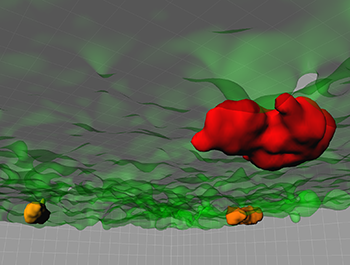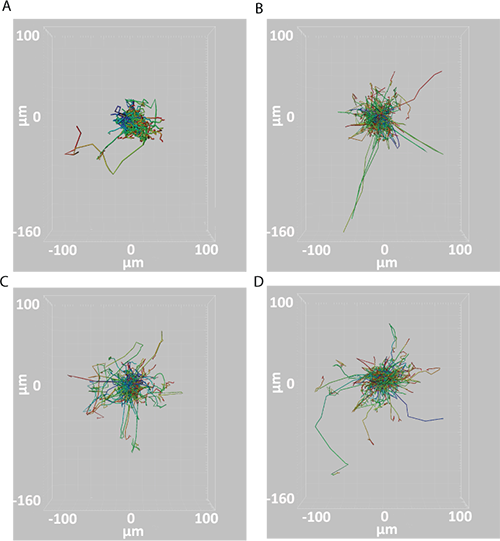Hardware Solutions
Applications
 Part of the Oxford Instruments Group
Part of the Oxford Instruments Group
Protocols

3D reconstruction of DC (red and orange) situated just beneath the lung epithelium (green)
Dendritic cells (DC) are professional antigen processing cells, playing an important role in the adaptive immune system and primary immune response. They are found in peripheral and lymphoid tissues, and are particularly abundant at the interfaces between our bodies and the environment in organs such as the skin or the lung. To initiate and shape the immune response, DC have to migrate and mature.
It is challenging to quantitatively investigate processes that regulate human DC distribution, activation, and migration in vivo. Therefore, researchers led by Dr. Mattias Svensson from the Center for Infectious Medicine, Karolinska Institutet, developed organotypic lung model that displays morphological and functional characteristics of the human tissue.

Figure 4. Visualizing DC exploring the lung tissue microenvironment in response to TLR-1/2 and 4 ligands and the chemokine CCL2. (A-D) Visualizing DC motility in displacement graphs composed of data from unstimulated tissue models or tissue stimulated with 100 ng/ml LPS or 500 ng/ml TLR1,2L or 100 ng/ml CCL2. Tracks showing the path of each representative cell relative to the point of origin (time point zero) in the x and y plane. Plus or minus on the respective axis indicates migration in a particular direction. All results are representative of at least 3 independent experiments.
To quantitatively investigate DC migratory behaviour in response to various stimuli live-imaging fluorescence microscopy data were analysed with Imaris Surface tracking algorithm and Imaris Vantage. These results combined with flow cytometry analysis enabled the researchers to demonstrate that an organotypic model of the human lung could be successfully used to investigate lung DCs morphological alteration, spatial and temporal behaviour.
This protocol may serve as a useful tool for investigations regarding human DC differentiation, activation, and function in tissue and may be particularly important identifying adjuvant and vaccine candidates.
Nguyen Hoang AT, Chen P, Björnfot S, Högstrand K, Lock JG, Grandien A, Coles M, Svensson M, Technical advance: live-imaging analysis of human dendritic cell migrating behavior under the influence of immune-stimulating reagents in an organotypic model of lung.
